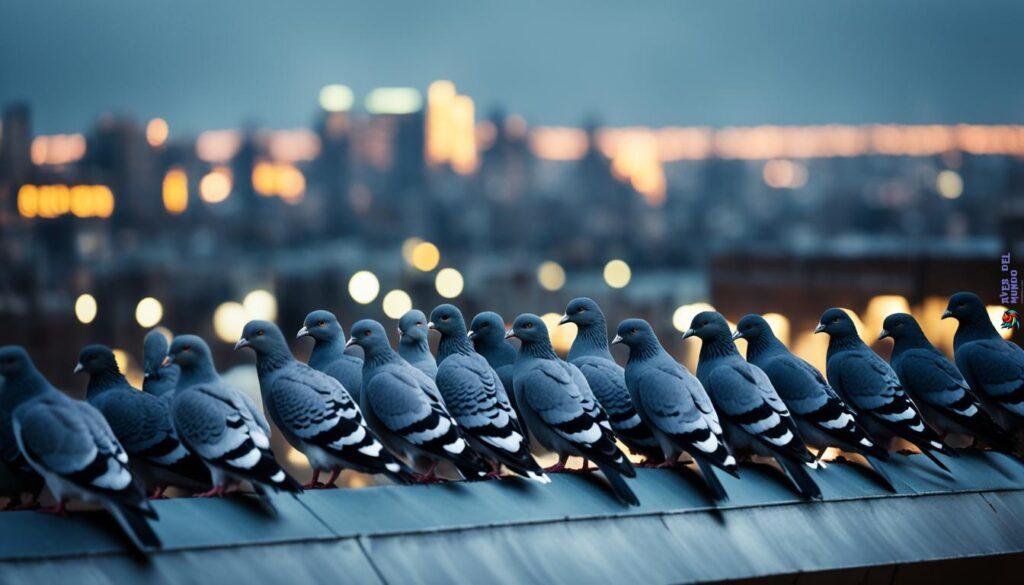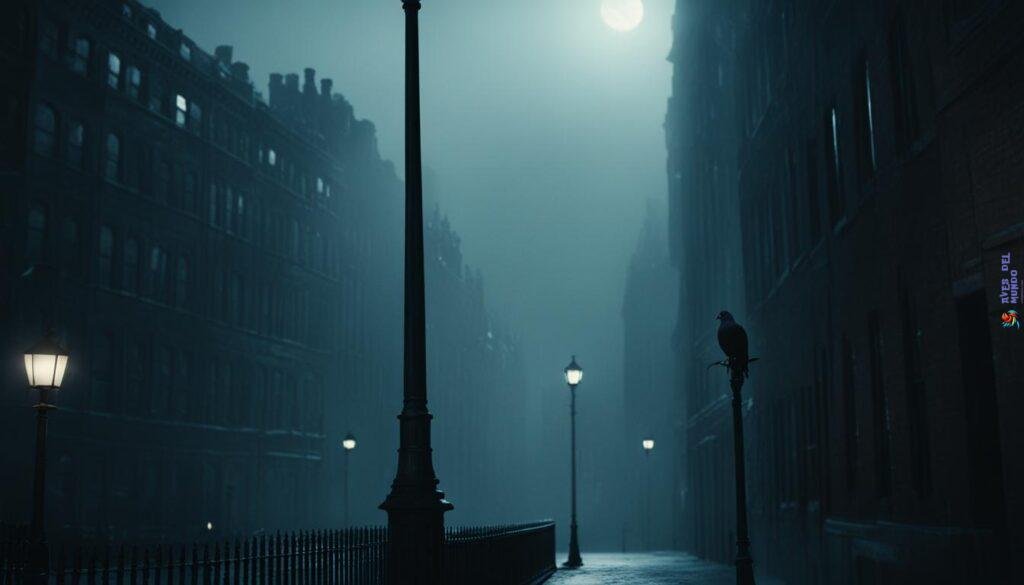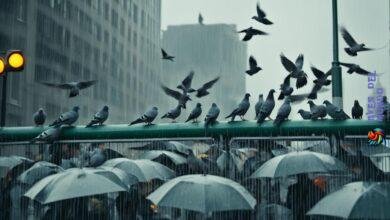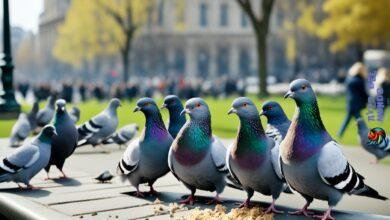As the sun goes down, city pigeons, always around during the day, suddenly disappear. Every night, millions of these birds in the U.S. fade from view. But where do they go when it gets dark? We look into the nocturnal pigeon locations and uncover the mysteries of pigeon roosting spots at night. Though they’re easy to spot in daylight, finding pigeons after dark is much harder. This reveals how well these urban birds can adapt.
Let’s dive into a night-time quest to understand these birds’ secret lives. Their night behavior has confused many for a long time. We’ll discover their hiding spots and why those are key for their survival.
Unlocking the Mystery of Pigeon Night Habits
When night covers the city, pigeons stop their daytime hustle, making us wonder, where do pigeons sleep? They start looking for hidden, safe places at twilight. Pigeons, skilled in city living, find spots where they can rest peacefully.
To find pigeons at night, you need patience. You must understand they look for safe, warm, and quiet places. Pigeons don’t sleep in trees like other birds. Instead, they sleep in places around the city that keep them safe from predators and bad weather.
Every evening, pigeons leave public spots to hide for the night. They keep going back to the same safe places, showing how important a safe sleeping place is for them.
Ever curious about where pigeons spend the night? Look up to building edges or check the protected spots under bridges. There, you might see pigeons getting ready to sleep. Let’s dive deeper into where they prefer to roost at night:
| Roosting Spot | Attributes | Reason for Preference |
|---|---|---|
| Building Ledges | Elevated, Out of Reach | Protection from ground predators, overview of surroundings |
| Under bridges | Sheltered, Dark | Seclusion from disturbances, shielded from weather |
| Window Sills | Recessed, Accessible | Warmth leaking from windows, ease of access |
| Warehouse Rafters | Indoor, High Ceilings | Intact from weather, ample space for flocks |
To watch pigeons at night, notice how they act when the day ends. They smartly use the city’s layout to fulfill their natural needs. Their ancestors rested on cliff ledges. As you walk the city at night, think about the quiet struggle for survival happening above. You might just see where pigeons sleep, hidden until the morning light.
Exploring Urban Pigeon Night Habits
As dusk falls, city streets transform. Pigeons, those day-time flyers, seek perfect spots for the night. This is where their secret life begins after sunset.
Seeking Shelter in City Structures
When the city quiets, we wonder where pigeons go. They find refuge in our buildings’ nooks. These spots range from behind billboards to bridge undersides, sheltering them from the elements.
Roof Rendezvous: Pigeons’ Love for High Places
Pigeons love the city’s skylines as much as we do. They prefer rooftops for their night rest. Here, they find quiet and safety from danger, relaxing after their busy day.
The Lure of Warmth: Pigeons Near Lights and Equipment
In cold nights, pigeons seek warmth from city lights. They are drawn to the heat from neon signs and street lamps. This warmth and light comfort them, mimicking daylight.
We learn a lot about pigeons by observing their night habits. Their choice of spots shows their adaptability and cleverness. This reveals an unseen life within our cities after dark.
Where Are the Pigeons at Night?
As the sun sets and the city quiets, you might wonder where pigeons go at night. Unlike during the day, pigeons hide expertly in the moonlight. They find safe places to rest until the morning comes. This tells us about their survival skills in our cities.

Pigeons are creatures of both habit and adaptation. As night falls, they vanish to their chosen spots. These spots keep them safe and cozy all night. It shows how well pigeons can live with us, hiding in plain sight.
Pigeons, through evolved instinct, favor locations that provide warmth and seclusion. As it gets dark, they head to the city’s skyline for safety. There, they’re safe from the world below, hidden in shadows.
As dusk descends, pigeons use the dwindling light to navigate towards their night roosts, and by the time the city is enveloped in the velvet of late evening, they are settled in. – Urban Wildlife Expert
If you pay attention, you can spot hints of their hiding places. You might see feathers, droppings, or hear their cooing at night. These clues can lead us to find them. And as the sun rises, pigeons rejoin the city’s life, no longer hidden.
Deciphering the Roosting Rituals of Pigeons
As the evening shadows grow, pigeons disappear, sparking curiosity about where they go. If you’re intrigued by urban wildlife or just want to know more about pigeons, exploring their nighttime rituals is fascinating. Learning how to find pigeons at night opens up a secret world above us with tips for locating pigeons at night and exploring urban pigeon night habitats.
Hidden Away: How Pigeons Find Discreet Nocturnal Spots
Pigeons prefer to stay hidden at night, blending into the city. They find spots that remind them of cliffside homes, safe from danger. Look for hidden places where pigeons feel safe from predators and bad weather if you’re searching at night.
Nestled in Niches: Pigeons’ Use of Urban Architecture
City buildings provide perfect night homes for pigeons. At dusk, they gather in secure spots hidden in the architecture. These clever birds fit themselves into small spaces for safety during the night. This adaptation shows how pigeons make the city their safe haven.
To see pigeons at night, patience and exploring safe spots are key. This will let you see how pigeons adapt to city life at night. It’s not only about finding pigeons but appreciating these city dwellers in a new light.
Natural Nighttime Niches for Pigeons
When you look for finding pigeons after dark, it’s fascinating to see. Even in the city, pigeons follow their wild instincts at night. People who enjoy tracking pigeons in the dark see how nature still pulls these city birds back.
Pigeons prefer places like their natural homes—rocky cliffs and leafy trees, in less urban areas. Such spots help them blend in at night. If you’re close to nature, watch closely. You might find pigeons resting in the quiet nooks of cliffs or amidst the branches.
Pigeons in nature stick to safe spots for nighttime rests. When tracking pigeons in the dark, look for places that protect them from rain and predators. A rocky overhang or thick tree canopy can be perfect shelters.
If you want to succeed at finding pigeons after dark away from cities, get ready for a challenge. It reminds us of the strong, lasting connection pigeons have with their wild origins. They continue to use natural spaces, proving that the wild’s call cannot be silenced by city life.
Understanding the Nightly Challenges for Pigeons
When the sun sets, pigeons look for safe places to spend the night. These birds, common in cities during the day, face many dangers at night. They must find their spots to rest in the dark.
Resilience in harsh conditions is key for pigeons. They seek warmth near neon signs and find shelter in big buildings. This shows their strength and ability to adapt to city life.

Battling the Elements: Pigeons’ Survival Strategies
Pigeons search for shelter to escape rain or snow. They find spots under bridges or on beams, holding on tightly. This search for safety is a big part of their night lives.
Evading Predators in the Darkness
Pigeons also have to avoid predators at night. Hawks and other birds of prey are a threat. They pick spots that are high up and hidden to stay safe. These places give them a good view and keep them hidden.
The difference between day and night brings real challenges for pigeons. They show courage and cleverness in finding places to roost. As we go to bed, pigeons start their night, overcoming dangers and the cold. They claim their space in the city’s night life.
How to Spot Pigeons in Their Nocturnal Hiding Places
When night falls and cities become quiet, pigeons find secret places to rest. If you’re interested in finding pigeons at night, you need to know where to look. Often, the clues to their location are right in front of us.
Noticing the Subtle Signs of Pigeon Presence
Sneaky at night, pigeons still leave clues. Look for pigeon droppings to find where they hang out. When walking at night, look up at bright signs and street lights. You might see pigeons’ shapes against the city lights, silent and still.
Observing Pigeons: Tips from Enthusiasts and Experts
Those who know pigeons well give great advice for spotting them at night. They suggest looking in warm places, like near heating vents or neon signs in colder months. Pigeons like these spots for the warmth they offer. Knowing their habits helps in tracking them.
Pigeons may seem gone when it gets dark, but they follow routines. By being patient and watchful, you can learn their patterns. You can watch them find their night spots in the city’s secret corners.
The Ancestry of Nocturnal Roosting in Pigeons
When the day ends and cities quiet down, pigeons find their spots for the night. They follow an old instinct. Wondering where do pigeons sleep? It takes us back to their ancestors, the rock doves. These birds lived in danger from predators. So, they chose high spots on coasts and in rocks to stay safe. Modern pigeons still do this.
Our urban pigeons, the rock dove descendants, love high, hidden places for sleeping. Their favorite spots are like their ancestors’ natural homes. When you look for where do pigeons sleep?, you’ll see they avoid the ground. They stay up high, far from dangers.
Just as their ancestors did, pigeons use heights to their advantage, ensuring a safe night’s sleep away from the lurking dangers of nocturnal city life.
The link between their past and how pigeons behave today is clear. Not just in where they sleep, but also in what they do every day. Below, we compare how their ancestors lived and how pigeons live now:
| Historical Roosting Trait | Contemporary Roosting Behavior |
|---|---|
| Cliff-side nesting for protection | High-altitude roosting on buildings |
| Seeking isolated crevices for safety | Choosing secluded spots away from disturbances |
| Preference for the vantage point to spot predators | Roosting in areas with a broad field of view |
| Dependency on ambient temperature of rocks | Gravitating towards warmth-emitting structures |
The question of where do pigeons sleep? shows their night instincts have stayed strong. Even as their world changed, they kept their survival skills. They remind us of the city’s lively nature.
Adaptations That Enable Pigeons to Thrive in the Dark
As night falls and the day’s noise fades, the secret life of pigeons’ late evening whereabouts begins. These birds have special ways to survive the night. Their skills and habits make them perfect for living in the dark city.
Pigeons have traits designed for night life. They prefer high spots for safety and to watch the city. Their sharp night vision helps them find food and move safely at night.
Here’s how pigeons use city spaces as shelters and warm spots:
- Sheltered Roosting: Pigeons find spots high up on buildings to stay safe from weather and predators, just like their ancestors did on cliffs.
- Warmth Seeking: They stay near heat sources like vents and neon signs to keep warm during cold nights.
Knowing about pigeons’ adaptations can change how we see these city birds. Their love for city life and ability to adapt to darkness shows their strong will to survive.
Pigeons: The Unseen Inhabitants of the Night
As evening falls and the city calms, you might wonder: where do pigeons go at night? These city birds, always around in the day, seem to disappear. By paying attention, the search for finding pigeons after dark turns into a fascinating journey. Pigeons pick roosts like statues or old bridge beams, showing their skill to adapt and follow instincts.
Exploring pigeons at night reveals their hidden side. In the city’s heart, under darkness, they change. They nestle in skyscraper ledges or near streetlights for safety. Pigeons look for good spots to rest at night, just like their forefathers dodged predators. Knowing this, the idea of finding pigeons after dark is less of a mystery. You just need to notice their subtle signs.
When it gets dark and pigeons seem to disappear, remember they are still close by. They thrive in the dark, showing their ability to fit into our urban world. Understanding their behavior makes their nighttime activity seem normal, even expected. Keep an eye out for them after dark.



